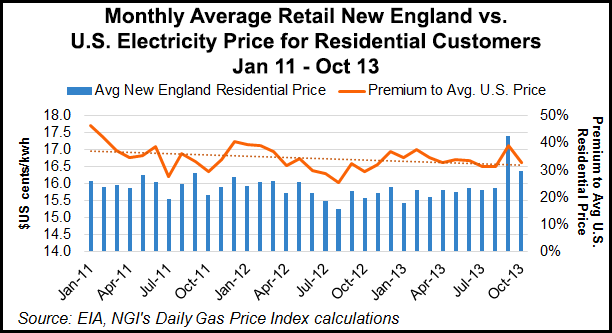Regulatory | Infrastructure | NGI All News Access
New England Governors Seek ISO-NE Buy-In on New Pipelines, Power Lines
Moving forward with their agreement to work together with the Independent System Operator of New England (ISO New England) to diversify the region’s energy supply portfolio, the governors of six New England states are calling on the grid operator to provide technical support and assistance with necessary tariff filings for new electric and natural gas infrastructure.

“New England’s electricity costs are not competitive,” said Maine Gov. Paul R. LePage. “Our high energy prices drain family budgets and are a significant barrier to attracting business investment, especially in energy-intensive industries such as manufacturing. But we are geographically positioned to take advantage of competitively priced natural gas and hydropower resources if we invest with other states in key infrastructure.”
In a letter to ISO New England CEO Gordon van Welie, the New England States Committee on Electricity (NESCOE), on behalf of the governors, asked for assistance as they request proposals for transmission infrastructure to deliver at least 1,200 MW and as much as 3,600 MW of electricity from clean energy sources into the grid, as well as to develop a funding mechanism to support investment in additional pipelines to bring natural gas from the Pennsylvania region into New England.
The additional pipeline capacity should be capable of delivering gas at prices similar to Henry Hub in amounts which, combined with firm commitments by other market participants, would increase the amount of firm pipeline capacity into New England of 1,000 MMcf/d above 2013 levels or 600 MMcf/d beyond what has already been announced for the Algonquin Gas Transmission Incremental Market project (see Daily GPI, July 10, 2013) and Tennessee Gas Pipeline’s Connecticut Project (see Daily GPI, Nov. 25, 2013), according to the letter. Recovery of the net cost for procurement of the pipeline capacity is expected to be shared by the New England states.
NESCOE asked that ISO New England seek Federal Energy Regulatory Approval of a tariff for the recovery of the cost of the firm gas pipeline capacity “with the objective of allowing commitments to be made that would permit the new pipeline capacity to be available no later than the winter of 2017-2018.
“NESCOE does not have a single preferred mechanism for securing pipeline capacity under the requested tariff, but the New England States agree that they will work with ISO-NE and NEPOOL participants to develop and support, and take whatever steps are necessary and appropriate to facilitate, a structure that will ensure that the capacity obtained with the support of the postulated ISO-NE tariff will be made available in a manner that primarily benefits electricity customers in the ISO-NE market.”
The governors last month vowed cooperation to improve the region’s energy infrastructure (see Daily GPI, Dec. 6, 2013).
LePage this week urged legislators in his state to tackle energy challenges, with an emphasis on lowering residential heating bills, and natural gas, which has found Maine a hard market to crack (see Daily GPI, Jan. 21). Wholesale electricity prices in New England were up 57% in 2013 compared to 2012; the price of propane has jumped 22% since the heating season began in October; and the 70% of Maine households that use heating oil can expect to spend $3,200 on that fuel this winter, according to LePage.
Although the premium in electricity prices charged to residential users in New England has come down versus the average for the entire United States since early 2011, New England residential power prices were still a 33% higher than those incurred by the entire country in October. In fact, that premium was more than 30% for each of the first 10 months of 2013.
© 2024 Natural Gas Intelligence. All rights reserved.
ISSN © 1532-1231 | ISSN © 2577-9877 |
